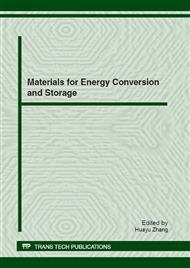[1]
Barthlott W, Neinhuis C. Purity of the sacred lotus, or escape from contamination in biological surfaces. Planta, 1997, 202: 1-8.
DOI: 10.1007/s004250050096
Google Scholar
[2]
Neinhuis C, Barthlott W. Characterization and Distribution of Water-repellent, Self-cleaning Plant surfaces. Annals of Botany, 1997, 79(6): 667-677.
DOI: 10.1006/anbo.1997.0400
Google Scholar
[3]
Feng L, Li SH, Li YS, et al. Super-hydrophobic surfaces: from natural to artificial. Advanced Materials, 2002, 14 (24): 1857-1860.
DOI: 10.1002/adma.200290020
Google Scholar
[4]
Watanabe K, Yanuar H, Udagawa H.Drag reduction of Newtonian fluid in a circular pipe with highly water-repellent wall. Fluid Mech, 1999, 381:225- 238.
DOI: 10.1017/s0022112098003747
Google Scholar
[5]
Ou J, Perot B, Rothstein J P. Laminar drag reduction in microchannels using ultrahydrophobic surfaces.Phys Fluids. 2004, 16(12): 4635-4643.
DOI: 10.1063/1.1812011
Google Scholar
[6]
C Henoch, T N Krupenkin, P Kolodner, J A Taylor, M S Hodes, A M Lyons. Turbulent Drag Reduction Using Superhydrophobic Surfaces. 3rd AIAA Flow Control Conference 5-8 June 2006, San Francisco, California.
DOI: 10.2514/6.2006-3192
Google Scholar
[7]
LU Si, YAO Zhaohui*, HAO Pengfei, FU Chengsong. Drag reduction in ultrahydrophobic channels with micro-nano structured surfaces. SCIENCE CHINA: Physics, Mechanics & Astronomy, 2010, 53(7): 1298-1305.
DOI: 10.1007/s11433-010-4035-9
Google Scholar
[8]
Jiang Lei, Feng Lin. Bionic intelligent nano interface materials. Beijing: Chemical Industry Press, 2007: 51-142(in Chinese).
Google Scholar
[9]
Blevins R D. Applied Fluid Dynamics Handbook. New York: Van Nostrand Reinhold, 1984.
Google Scholar
[10]
Patanka N A. On the modeling of hydrophobic contact angles on rough surfaces. Langmuir, 2003, 19: 1249–1253.
DOI: 10.1021/la026612+
Google Scholar
[11]
Onda T, Shibuichi S, Satoh N, et al. Super-water-repellent fractal surfaces. Langmuir, 1996, 12: 2125–2127.
DOI: 10.1021/la950418o
Google Scholar
[12]
Chen W, Fadeev A Y, Hsieh M C, et al. Ultrahydrophobic and ultralyophobic surfaces: Some commentsand examples. Langmuir, 1999, 15: 3395–3399.
DOI: 10.1021/la990074s
Google Scholar


